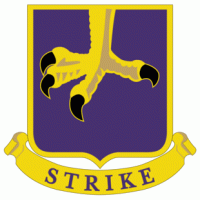
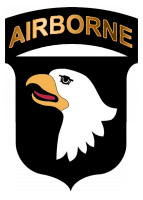 Fort Campbell, KY – All this week members of the Second Brigade Combat Team were out on the ranges of Fort Campbell honing the skills they will need for their upcoming deployment to Afghanistan. I was able to join them for a time on Thursday at Observation Point 12 (OP 12) where the soldiers of the Brigade were conducting a Fire Support Exercise that had started on Tuesday, and would run through Friday.
Fort Campbell, KY – All this week members of the Second Brigade Combat Team were out on the ranges of Fort Campbell honing the skills they will need for their upcoming deployment to Afghanistan. I was able to join them for a time on Thursday at Observation Point 12 (OP 12) where the soldiers of the Brigade were conducting a Fire Support Exercise that had started on Tuesday, and would run through Friday.
The exercise was training the brigade soldiers on how to combine different fire support assets in a combat situation including 80mm and 120mm mortars, 105mm artillery, along with Apache helicopters firing rockets and 30mm canons.
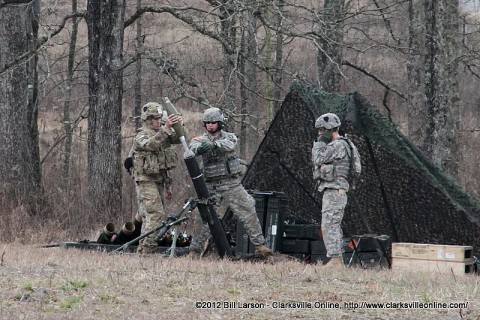
In situations such as these Fire Support Specialists reports the situation on the ground back to the Fire Support Officer, in this case Maj. Charles Price, who along with his Fire Support Team (FIST) directs specific assets to fire on the targets in question. Depending on the situation he will have a variety of options to deal with each target including fixed wing aircraft or helicopters in a close air support role, artillery, and mortars.
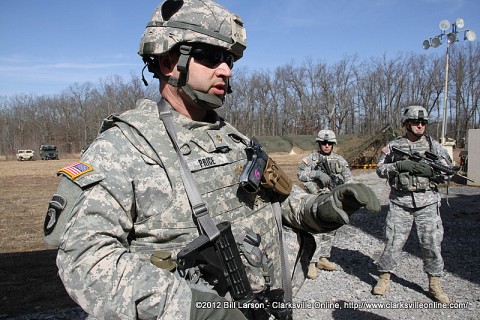
“Being out in the field makes you more focused,” said Maj. Price. “Just hearing the rounds come in will make you step up your game.” Having been deployed multiple times, Price was asked about the coming deployment; “My mindset is achieving the mission and keeping moving forward. Whatever is asked, I will go over, execute, and make it happen!”
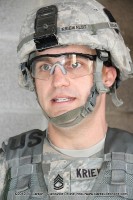
SFC. Michael Kriewaldt is a Platoon Sergeant with the 2nd Battalion, 502nd Infantry Regiment; he was one of the soldiers training that day, “We are training on various indirect fire systems that are combat enablers which will help us when we are deployed to Afghanistan,” he said. “As an NCO we are a jack of all trades. We are all trained on the same tasks so that if something happens, someone else can take over and do whatever job that needs to be done.” This will be his first deployment to Afghanistan, but he has been to Iraq twice before, so the mission is not a new one for him.
When an order for fire comes in, the first steps are to check to ensure the target coordinates are in the basket or safety fan, which sets a left limit and right limit along with a minimum and maximum firing distance. In a training situation you are ensuring that the fire will not affect neighboring ranges or aircraft that may be flying by; in the combat zone, it will ensure safety for civilian populations and other coalition units who may be operating in the area.
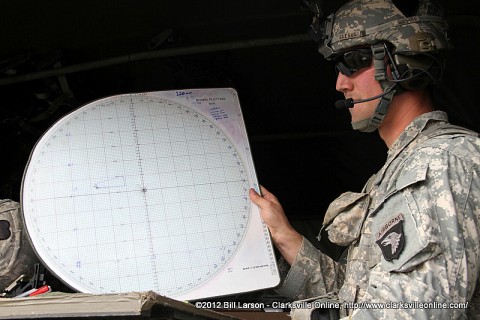
Once the coordinates are verified as safe, the orders are then relayed to the individual assets that will be engaging in the mission. They are told where the fire needs to impact, the number of rounds to fire, along with the type of ammunition to be used, and what fusing should be on the rounds.
The order to fire is given, and the assets launch their attack.
Below is a video of Soldiers from the 2nd Brigade of the 101st Airborne Division, 1-75 Cavalry, firing a 120mm mortar at Forward Operating Base (FOB) Wilson in Kandahar province, southern Afghanistan in support of their unit that was under attack at a combat outpost two kilometers to the south.
This is the final live fire training before the soldiers head for the Joint Readiness Training Center in Fort Polk, LA.
The Coming Deployment
After training there, the brigade will be divided up into around thirty 12-18 man teams who be heading to Afghanistan for a nine-month long deployment where they will be participating in Security Force Assistance Teams (SFAT) that will be paired up with Afghan National Security Forces to provide advice, assistance, and training for Afghan forces. The remainder of the Brigade will be remaining at Fort Campbell.
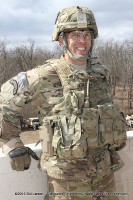
United States Army Colonel Daniel R. Walrath, the Commander of the 2nd Brigade Combat Team, spoke to the media about their upcoming mission in Afghanistan.
As every one knows currently there are about 90,000 Soldiers, Marines, Airman, and Sailors involved in combat operations in Afghanistan, Operation Enduring Freedom. The President has directed by the end of 2012 that the troop strength be decreased by 23,000, in effect to recover the remainder of the surge. When that happens, the ISAF will transfer increased responsibility to the Afghan National Security forces, Army and Police units.
To make that happen, the Army beginning this spring will organize, train, and deploy small teams to advise assist and train these Afghan forces to prepare them to take on these new responsibilities to take the lead and to facilitate this transition of responsibilities to them. This Brigade, the 2nd Brigade Combat Team “Strike” will be part of that effort.
Back in December Forces Command directed us to prepare for this new mission, specifically to organize, train, and prepare to deploy over 30 of these Security Force Assistance Teams. That is kind of what you are seeing here today. It is part of that training effort prior to our deployment this spring.
Our purpose is going to be to go overseas and assist with the development of Afghan security forces to facilitate this upcoming transition of responsibility to them to eventually take the lead.
It’s a challenging mission but it’s what the situation on the ground requires. I will tell you from having completed an on-the-ground reconnaissance last month. I am excited about the opportunity for significant contribution that these teams are going to be able to make to the ongoing fight. I would argue that by time all is said and done this security force is going to become the decisive effort in securing long and lasting stability in Afghanistan.
From this brigade we’ve got a great team of soldiers, leaders, and families. That team is confident that we will be successful in preparing for and executing this mission.
This brigade has a great history and as we go out on this next rendezvous with destiny, I am confident that we are going to live up to our motto that we’re strike, we fight where we are told, and we win where we fight, meaning that whatever mission comes to us we are going to figure it out and do it to the best of our ability and be successful at it. That is what we are focused on.
Col. Walrath pointed out that the mission of these soldiers is to advise these Afghan units. “It’s not so much as teaching the Afghans how to fight; it’s teaching them on how to sustain themselves as a force. The Afghans are a proud and independent force, and they want to be a strong and capable security force for their country. If there is something the Afghan forces can do for themselves we want them to do it for themselves; because if we step in and do it, we are not teaching them how to get it done. We are there on the ground to help coach/mentor, and when necessary to provide critical enablers to assist in their continuing fight, such as we are training in here today, artillery and aviation support.”
The mission is not a new one. Col. Walrath said. “Advising and partnering with Afghan units is not something new. This was part of this Brigade’s mission last deployment. Though the way we are organizing for it is new; the fact that we are going to be embedded with the Afghan forces is not new for this Army; it’s not new for this brigade. Our new mission is a significant increase in our advisory capacity, and that holds the single greatest potential for significant progress in Afghanistan over the next 1 to 2 years. These teams are leader heavy, each with a core group of experienced leaders and soldiers with combat experience. The majority of them were with this Brigade during its last deployment to Afghanistan.”Walrath sees the progression to smaller teams of advisors as a sign of continuing progress in Afghanistan, “This is what we have been working for since the beginning of the Army’s mission in Afghanistan, to transition the responsibility for security to the Afghan Security Forces.”
Maj. Gen. James McConville, the Commander of the 101st Airborne Division, has expressed his confidence in the abilities of the soldiers of the 2nd Brigade Combat Team from Fort Campbell, “Once again, the 502nd Infantry Regiment will answer the nation’s call and live up to the legacy of the great Soldiers who have gone before them. I have complete confidence in the officers and non-commissioned officers selected to participate in this mission. Air Assault!”


























